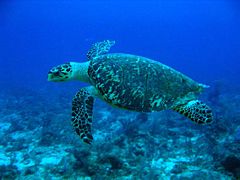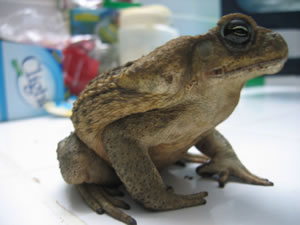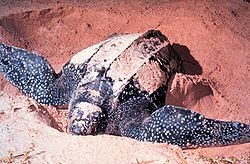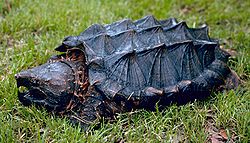Category Archives: Turtles & reptiles
Two species of African Slender-Snouted Crocodile – Mecistops cataphractus
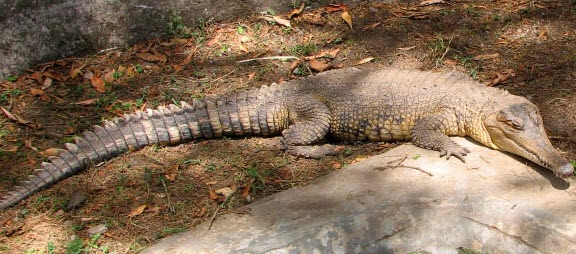
Image credit: Leyo
An international team of researchers from the University of Florida and the SFM Safari Gabon have through DNA Testing discovered that the African Slender-Snouted Crocodile ( Mecistops cataphractus) is actually two different species. Continue reading
Gigantic Crocodile? The Thing Nightmares are Made Of!
There are some that are afraid of sharks, big whites, tiger sharks or even dog sharks.. However, even more sinister, is the croc!
Since the time we were tiny, alone in our beds in the night, giant crocs have haunted our dreams, and we always end up waking up in a cold sweat after a croc tries to wrap its jaws around you.
Whatever the shrinks might say about these dreams, going on a volunteer mission to try and come face to face with a monster croc is not the world’s brightest idea.
Two weeks ago Herbie Harold discovered huge crocodile slide marks and claw prints just up the way from the Gulf of Carpentaria township of Normanton. Tie in the fact that the town pastor, Elton Thompson, has also seen this huge croc, and put photos up on his facebook, and you have the makings of a croc hunting adventure!
The croc was a real whopper, coming in at 8 meters in length, and is quickly capturing the attention of the nation.
So now there was someone to lead us to the croc, and someone to give the last rites.
Generally speaking, if a priest is wielding a foot long dagger in his belt, it’s usually cause for concern. However, when you are tracking a huge croc, it’s overlooked.
The journey begins by heading out to the favorite fishing haunt of Herbie, a small area on the banks of the Norman River. The markings of its claws can still be seen, and are small compared to the priest’s size fourteen shoes.
There is no croc to be seen though, so that night our intrepid interlopers head back in a 3.8 meter dinghy, just large nough to fit the tail of the monster croc they seek.
So, there is a large croc out there, the question is… Where is it??
Attempts to Move Se Turtle Eggs Out of Gulf Oil Spill Proving Fruitful
We have all heard of the BP oil spill fiasco in the Gulf of Mexico. As the black goo made its way to the beaches of Alabama and Florida officials of those states began an effort to attempt to save the batch of sea turtles.
Their plan was to dig up thousands of the turtle eggs and then move them over to the Kennedy Space Center, so that they could be born in an oil free environment. As we know, not many sea turtles actually make it in the wild, they didn’t need the extra obstacle of coming into the world in an oil slick.
If even a few of these turtles survived, officials commented, it would be considered a grand success.
Based on the first raw data coming in, “it’s been more of a success than we thought it would be,” a spokesman for the US Fish and Wildlife Service, Chuck Underwood, commented this past Friday.
Of the thousands – somewhere over 25,000 – of eggs moved, 14,676 were hatched successfully and were then let go in the Atlantic Ocean. This means that over half of the turtle eggs which were moved actually hatched, and nearly 6 out of every 10 turtles made it into the black goo free water.
“We do feel it was a success that we got that number of hatchlings into the sea,” commented a spokeswoman for the Florida Fish and Wildlife Conservation Commission, Patricia Behnke. “Of course, what happens to them after that, we don’t know. But we never do.”
Cane Toads Wiping the Floor With Crocs!
Cane toads are killing off the freshwater crocodiles which make their home in the Victoria River District in Australia. The toads have been credited for the demise of hundreds of these crocs, and don’t show any sign of letting up any time soon.
A group of scientists have been studying the happenings of the Victoria River since 2005, to take a gander at how the toad is effecting the local wildlife.
The leader of the group, Dr. Mike Letnic, has recently returned from a scouting trip to the area.
“I haven’t put all of the figures together yet but when we look at the data from Victoria River Downs, where the cane toads came through in 2006, the crocodile populations are down as much as 80 per cent.
“We did test some crocodiles a few years ago, some of the survivors, but we found no evidence that they had any immunity.
“The other idea we had was that the crocodiles might learn to avoid toads and we found a little bit of evidence in the laboratory, that crocs will learn.
“But in the wild it seems to be a different story, we keep seeing crocodiles chomping on toads.”
Yes, you would think the crocs would learn, however, seems that when a croc goes to chomp a cane toad, none of the other crocs are watching… Seems to me the crocs need to come up with a defensive plan, and soon, before they are all wiped out.
Inhumane Killing of Giant Alligator Sparks Public Outcry
People from all over the US have been crying foul, over the way an American woman killed a humongous 465 kilogram alligator in South Carolina.
Mary Ellen Mara-Christian, a 48 year old thrill seeker, has really made quite an impact across the US, as the small woman who conquered a huge gator.
However, the way in which she killed it has been getting some rather angry persons lashing back. She took two hours to finally kill the beast.
“This woman should be in jail, not on TV,” wrote one outraged user on carolinalive.com, a new website out of South Carolina.
You see, it took them two hours to tie the gator up, and then proceeded to shoot it 8 times with a .22 calibre gun. However, the 8 shots did nothing to ease the alligator of its suffering, and she eventually killed the poor thing by ripping out its spinal cord.
.
The general concensus of the online world is that her bahavior is nothing more than “senseless brutality”.
“They tortured that alligator for hours. That’s just plain sick,” a commenter wrote on Bostonherald.com.
“This is trophy hunting at its worst,” commented another reader on Cbsnews.com.
However Mrs. Mara-Christian is very proud of herself, and says the act was to do her part to save the alligators, as part of her idea of population control.
“I hunt because I want these creatures to be here forever,” she commented to The Boston Herald.
Well, this reporter, while having no great love for gators, sides with the online readers consensus, there was no need to torture it before killing it.. There is no talk of criminal charges, but there should be…
Two-Headed Turtle in Phuket Needs Name
Well, this is certainly interesting news. It appears that a two-headed turtle (Picture gallery) has gripped the attention of Phuket, and may turn into a full blow two-headed turtle mania if the media coverage is any indication.
The Royal Thai Navy has created a contest to help come up with a suitable name for the 18-day old turtle, which really created a stir when it was put on display in the turtle sanctuary at the Navy base in Tablamu, just to the north of Phuket.
Chatjen Choipean, a warrant officer who is in charge of many functions at the Navy hatchery beach at Hu Young Island in the Similans has commented that the two-headed turtle was the last in a batch of 26 turtles to hatch from the laying of 96 eggs. Turtles often lay there eggs on the beach between November and February.
This Olive Ridley turtle, officials are keeping their fingers crossed, may just do the same thing for Phuket and other turtles that a young panda has done for the Chinang Mai Zoo.
Last year, Warrant officer Chatjen explained, there were 80 separate nests made and eggs laid on the island. However, so far this year, there have only been 30.
”The young two-headed turtle is very strong and doing well,” he commented. This is the first time that a two-headed turtle has made an appearance in the Navy region, and many hope that it is a sign of good luck for the breeding attempts in the future, especially on the mainland and Phuket.
Visitors are encouraged to view the turtle at Tablamu, where they can also take advantage of one of the best golf courses in the area, and engage in one of many of the activities available in the surrounding Phang Nga countryside.
It is not known whether the two-headed turtle is male or female, and it could take up to 5 years to discover which it is, however, this will have no bearing on the decision of a name.
Rare “Princess” Turtle Makes Way Home After 32 Years
Well, they say turtles are slow, but this particular beauty made a surprise comeback to a Malaysian beach after an astonishing 32 years. A report issued Friday hailed this return as a “miracle” by conservationists and rekindling hope that the endangered species is not quite gone yet.
The leatherbacks, the biggest of all the sea turtle species, were at one time the stars of the show at Rantau Abang beach in the northern state of Terengganu. However, overfishing, poaching, and pollution have caused the population of these turtles to take a nose dive over the years, to the point of being critically endangered.
This turtle, aptly named “Puteri Rantau Abang” or Rantau Abang Princess, and identified by some special markings, had returned last month to finally end the long period of time that turtle sightings were rare, which began in Terengganu in the 1980’s.
“It is a miracle that leatherback turtles are making a comeback to this area,” commented, Ahamad Sabki Mahmood, the Malaysian Fisheries Department director-general.
He went on to explain that the return of this turtle proves that Rantau Abang is once again being made a nesting ground for turtles, he is hoping that the next possible nesting period between the 15th of August and 20th of August that more turtles will make an appearance.
This just goes to show you that old habits die hard, and that mother nature triumphs over all. Hopefully the future turtles which land at the beach will receive as warm a welcome.
Filipino Government Lays the Smackdown on People Poaching Sea Turtles
Two years after their detainment, 13 poachers, from Vietnam, who were caught with the dead bodies of 101 endangered Hawksbill turtles (known in scientific circles as Eretmochelys imbricata) near El Nido, northern Palawan, in the Philippines, have finally been convicted and sentenced to hefty fines along with some jail time.
On the 22nd of June, The Regional Trial Court of Puerto Princesa, Branch 50, after much deliberation, decided that the Vietnamese poachers should face jail time for their heinous acts, and will receive anywhere from 6 to 18 months, plus have some hefty fines to pay.
Since the poachers have been sitting in jail since the 2nd of September 2008, the court also decided that they will only have to cough up the money for the fines.
Two Filipino gunboats apprehended the Vietnamese boat transporting the poachers five miles east of Cabaluan Island near El Nido on August the 29th 2008. In a sheer act of desperation, the 13 crew members aboard the boat tried to sink her by flooding the holds, however were preented from doing so by law enforcement officers.
When the cargo holds were explored, they discovered the corpses of 101 Hawksbill Turtles, classified as being critically endangered, which is the highest risk rating for any living animal. This rating was handed down by the IUCN, the International Union for Conservation of Nature, some time ago.
So, they did the crime, they served the time, now all that remains is for them to pay the fine… Although, is it really enough? Did the poachers learn their lesson? Or were they simply sorry they were caught?
More Than 30 Dead Sea Turtles Found in Guatamala
More than 30 sea turtles have washed up in Guatamala’s southern coast, dead, mutilated and showing signs of suffocation, authorities have reported.
The National Council of Protected areas has said that the turtles were discovered on the beaches of Sipacate and Monterrico.
Upon closer examination the turtles appeared to have succumbed to suffocation after having been trapped in fishing nets, the organization went on to explain, they added that the fishermen responsible were using fish hooks in zones labeled as being “off limits”.
According to the law of Guatamala, fishing nets are supposed to have a turtle excluder device (TED), which will allow any turtles trapped by accident to escape quickly, easily and unharmed.
The reason that this is most troubling is due to the fact that the nesting season has just gotten underway, and there are already efforts in place to protect these magnificent turtles which are already threatened. This statement comes from the head of the organization’s hydro-biological reources department, Jose Martinez.
There are six different kinds of sea turtle which nest in Guatamala, all of them are in danger of becoming extinct, due to human activities such as poaching, over harvesting of the eggs, and of course, pollution.
There are going to be further steps taken to help the protect the turtles, but it’s a big ocean, and there aren’t enough resources to provide for 24 hour surveillance of every nook and cranny.
Crikey! Alligator Snapping Turtle Caught in England!
Alligator Snapping Turtle
A fisherman, Steve Bellion aged 23, was out at Earlswood Resevoir angling for carp when he caught a little more than he bargained for. He managed to reel in a 57 lb (27 kg) reptile!
He dragged it to shore where it was easily identified as an 80 year old alligator snapping turtle. This is a rare catch indeed, as these turtles are generally only found in the eastern corners of the United States.
This has solved a rather puzzling mystery for the local fishermen. There has been many a tale told for a decade, of a giant creature biting through lines and roughing up ducks.
The ancient Alligator Snapping Turtle, identified as being female, was transferred to the West Midland Safari Park, where it is going to be held in quarantine for the customary 30 days and checked over by the veterinary team there.
Alligator Snapping Turtles can live to be 160 years old, making it one of the longest living creatures to be hauled to shore in the area.
Once it has finished being checked over, it will be transferred to a vivarium with a male of the species.
“They have been known to attack small domestic pets or children, but I don’t think this one would have drifted to far from the water.” stated the director of wildlife at the safari park, Bob Lawrence. At first glance it seems that the turtle is in perfect health, as it should be after gorging itself on the local wildlife.
He went on to add that this really brings to light the danger of introducing foreign species into Britain’s waterways, much the same way that American signal crayfish have created quite a dip in the UK’s national crayfish population.
